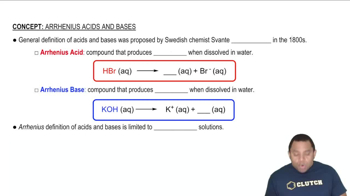Ch.22 - Chemistry of the Nonmetals

Brown15th EditionChemistry: The Central ScienceISBN: 9780137542970Not the one you use?Change textbook
Chapter 22, Problem 31
Complete the exercises below. Write the chemical formula for each of the following, and indicate the oxidation state of the halogen or noble-gas atom in each: a. calcium hypobromite, b. bromic acid, c. xenon trioxide, d. perchlorate ion, e. iodous acid, f. iodine pentafluoride.
 Verified step by step guidance
Verified step by step guidance1
Step 1: Identify the chemical formula for each compound. For calcium hypobromite, the formula is Ca(BrO)_2. For bromic acid, the formula is HBrO_3. For xenon trioxide, the formula is XeO_3. For perchlorate ion, the formula is ClO_4^-. For iodous acid, the formula is HIO_2. For iodine pentafluoride, the formula is IF_5.
Step 2: Determine the oxidation state of the halogen or noble-gas atom in each compound. Start with calcium hypobromite, Ca(BrO)_2. The oxidation state of oxygen is typically -2. Use this to find the oxidation state of bromine.
Step 3: For bromic acid, HBrO_3, use the known oxidation state of hydrogen (+1) and oxygen (-2) to calculate the oxidation state of bromine.
Step 4: In xenon trioxide, XeO_3, use the oxidation state of oxygen (-2) to determine the oxidation state of xenon.
Step 5: For the perchlorate ion, ClO_4^-, and iodous acid, HIO_2, and iodine pentafluoride, IF_5, apply the same method: use the known oxidation states of other elements to find the oxidation state of chlorine, iodine, and iodine, respectively.
Key Concepts
Here are the essential concepts you must grasp in order to answer the question correctly.
Oxidation States
Oxidation states, or oxidation numbers, indicate the degree of oxidation of an atom in a compound. They help in understanding electron transfer during chemical reactions. The oxidation state is assigned based on a set of rules, such as the oxidation state of an element in its elemental form being zero, and the sum of oxidation states in a neutral compound being zero.
Recommended video:
Guided course

Oxidation Numbers
Chemical Formulas
A chemical formula represents the composition of a compound, showing the types and numbers of atoms present. For example, in calcium hypobromite (Ca(BrO)2), the formula indicates one calcium atom, two bromine atoms, and two oxygen atoms. Understanding how to derive chemical formulas from names is essential for accurately identifying compounds and their properties.
Recommended video:
Guided course

Skeletal Formula
Acids and Bases
Acids are substances that can donate protons (H+) in a solution, while bases can accept protons. The strength of an acid or base is determined by its ability to dissociate in water. For example, bromic acid (HBrO3) is a strong acid that dissociates completely in solution, affecting the oxidation states of its constituent elements and their behavior in reactions.
Recommended video:
Guided course

Arrhenius Acids and Bases
Related Practice
